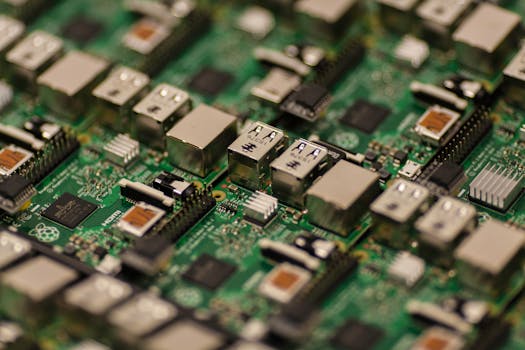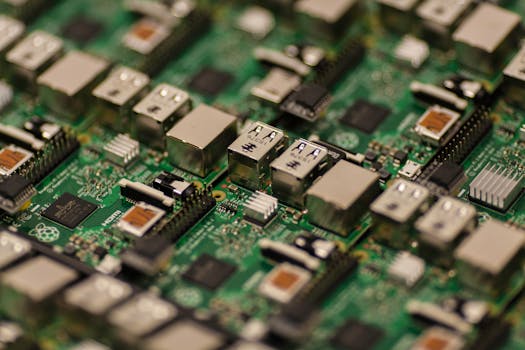Benefits of Using Raspberry Pi for Video Surveillance
Video surveillance systems have become an essential tool for ensuring security and monitoring activities in various settings, such as homes, offices, and public spaces. With the advancement of technology, these systems have become more sophisticated and accessible, making it easier for individuals to set up their own surveillance systems. One popular option for building a video surveillance system is by using a Raspberry Pi, a small and affordable computer that can be easily configured for various purposes. In this article, we will explore the benefits of using Raspberry Pi for video surveillance and how it can help you build a reliable and cost-effective surveillance system.
One of the main advantages of using Raspberry Pi for video surveillance is its affordability. Compared to traditional surveillance systems, which can cost hundreds or even thousands of dollars, a Raspberry Pi can be purchased for as low as $35. This makes it a budget-friendly option for those who want to set up a surveillance system without breaking the bank. Additionally, Raspberry Pi is a versatile device that can be used for various purposes, making it a cost-effective investment in the long run.
Another benefit of using Raspberry Pi for video surveillance is its compact size. The device is small enough to fit in the palm of your hand, making it easy to conceal and install in different locations. This is especially useful for covert surveillance, where you want to monitor an area without drawing attention to the camera. The compact size of Raspberry Pi also makes it a portable option, allowing you to move the surveillance system to different locations as needed.
Raspberry Pi is also known for its low power consumption, making it an energy-efficient option for video surveillance. Traditional surveillance systems often require a significant amount of power to operate, which can result in high electricity bills. With Raspberry Pi, you can save on energy costs while still having a reliable surveillance system in place. This is particularly beneficial for those who want to keep their surveillance system running 24/7 without worrying about the impact on their electricity bill.
In addition to its affordability, compact size, and low power consumption, Raspberry Pi also offers a wide range of features that make it a suitable choice for video surveillance. The device is equipped with a powerful processor, high-quality graphics, and various connectivity options, allowing you to customize and enhance your surveillance system according to your needs. You can also add external storage devices to store video footage, making it easier to manage and access the recordings.
Moreover, Raspberry Pi is an open-source platform, which means that the software and hardware specifications are freely available for anyone to modify and improve. This allows for a community of developers to constantly work on enhancing the capabilities of Raspberry Pi, making it a reliable and up-to-date option for video surveillance. You can also find a variety of software and applications specifically designed for Raspberry Pi, making it easier to set up and manage your surveillance system.
In conclusion, using Raspberry Pi for video surveillance offers numerous benefits, including affordability, compact size, low power consumption, and a wide range of features. Whether you are looking to set up a surveillance system for your home, office, or any other setting, Raspberry Pi provides a cost-effective and reliable solution. With its versatility and constant development, Raspberry Pi is a popular choice for building a video surveillance system that meets your specific needs.
Step-by-Step Guide to Building a Raspberry Pi-Powered Video Surveillance System

Video surveillance systems have become an essential tool for ensuring the safety and security of homes, businesses, and public spaces. With advancements in technology, it is now possible to build a cost-effective and customizable video surveillance system using a Raspberry Pi. This small, single-board computer can be easily configured to function as a powerful video surveillance system, making it a popular choice among DIY enthusiasts and professionals alike.
If you are interested in building your own Raspberry Pi-powered video surveillance system, this step-by-step guide will walk you through the process.
Step 1: Gather the Necessary Materials
The first step in building a Raspberry Pi-powered video surveillance system is to gather all the necessary materials. You will need a Raspberry Pi board, a camera module, a power supply, a microSD card, and a case to house the components. Additionally, you will need a monitor, keyboard, and mouse to set up and configure the system.
Step 2: Install the Operating System
The Raspberry Pi requires an operating system (OS) to function. The most popular OS for Raspberry Pi is Raspbian, a free and open-source OS based on Debian Linux. To install Raspbian, you will need to download the image file from the official website and flash it onto the microSD card using a tool like Etcher. Once the OS is installed, insert the microSD card into the Raspberry Pi and connect it to a monitor, keyboard, and mouse.
Step 3: Configure the Raspberry Pi
After booting up the Raspberry Pi, you will need to configure it to enable the camera module. This can be done by accessing the Raspberry Pi Configuration tool from the main menu. In the Interfaces tab, select the Camera option and click on Enable. This will allow the Raspberry Pi to recognize and use the camera module.
Step 4: Connect the Camera Module
Next, you will need to connect the camera module to the Raspberry Pi. The camera module comes with a ribbon cable that needs to be inserted into the designated slot on the Raspberry Pi board. Make sure to secure the cable in place to avoid any loose connections.
Step 5: Install and Configure the Camera Software
To capture and record video footage, you will need to install camera software on the Raspberry Pi. One popular option is Motion, a free and open-source software that can be easily installed using the terminal. Once installed, you will need to configure the software to your preferences, such as setting the recording duration, frame rate, and resolution.
Step 6: Set Up Remote Access
To monitor the video footage remotely, you will need to set up remote access to the Raspberry Pi. This can be done by enabling SSH (Secure Shell) and VNC (Virtual Network Computing) on the Raspberry Pi. SSH allows you to access the Raspberry Pi through a command-line interface, while VNC allows you to access the graphical user interface remotely.
Step 7: Mount the Raspberry Pi
Once the Raspberry Pi is configured and connected to the camera module, you will need to mount it in a suitable location. The camera module comes with a small stand that can be attached to the back of the module, making it easy to mount on a wall or ceiling. Make sure to position the camera in a way that provides a clear view of the area you want to monitor.
Step 8: Test and Monitor the System
After completing all the steps, it is important to test and monitor the system to ensure it is functioning properly. You can access the camera software remotely through SSH or VNC and view the live footage. You can also set up alerts to notify you of any motion detected by the camera.
In conclusion, building a Raspberry Pi-powered video surveillance system is a cost-effective and customizable option for those looking to enhance their security measures. With this step-by-step guide, you can easily set up your own video surveillance system and have peace of mind knowing that your property is being monitored.
Tips for Enhancing the Security and Functionality of Your Raspberry Pi Video Surveillance System
In today’s world, security is a top priority for many individuals and businesses. With the rise of technology, video surveillance systems have become a popular choice for monitoring and protecting properties. However, these systems can often be expensive and complicated to set up. That’s where the Raspberry Pi comes in. This small, affordable, and versatile computer can be used to create a powerful video surveillance system. In this article, we will discuss some tips for enhancing the security and functionality of your Raspberry Pi video surveillance system.
First and foremost, it is important to choose the right Raspberry Pi model for your video surveillance system. The Raspberry Pi 4 is the latest and most powerful model, with features such as faster processing speed, higher RAM, and multiple USB ports. However, if you are on a budget, the Raspberry Pi 3 or even the Raspberry Pi Zero can also be used for a basic surveillance system. It is important to consider your specific needs and budget before making a decision.
Once you have chosen the right Raspberry Pi model, the next step is to select the appropriate camera. The Raspberry Pi camera module is a popular choice, as it is specifically designed to work with the Raspberry Pi and is easy to set up. However, there are also other options available, such as USB webcams or IP cameras. It is important to research and compare different cameras to find the one that best suits your needs and budget.
After setting up the hardware, the next step is to choose the right software for your video surveillance system. There are various open-source software options available, such as MotionEyeOS, ZoneMinder, and Shinobi. These software allow you to monitor and record footage, as well as set up motion detection and alerts. It is important to research and test different software to find the one that best fits your needs and is compatible with your chosen camera.
One of the key features of a video surveillance system is motion detection. This allows the system to only record when there is movement, saving storage space and making it easier to review footage. To enhance the motion detection capabilities of your Raspberry Pi video surveillance system, you can use external sensors, such as PIR sensors or ultrasonic sensors. These sensors can be connected to the Raspberry Pi and used to trigger the camera when motion is detected.
Another important aspect to consider is storage. The Raspberry Pi has limited storage capacity, so it is important to have an external storage device, such as a USB flash drive or an external hard drive. This will allow you to store more footage and prevent the Raspberry Pi from running out of storage space. It is also recommended to regularly back up your footage to prevent any loss of important footage.
In addition to enhancing the security of your video surveillance system, there are also ways to improve its functionality. For example, you can set up remote access to your system, allowing you to monitor and control it from anywhere using a smartphone or computer. This can be done by setting up a VPN or using a service like TeamViewer. You can also set up a live stream of your footage, allowing you to monitor your property in real-time.
Lastly, it is important to regularly maintain and update your Raspberry Pi video surveillance system. This includes keeping the software and firmware up to date, as well as regularly checking the hardware for any issues. It is also recommended to have a backup power source, such as a UPS, to prevent any interruptions in case of a power outage.
In conclusion, building a Raspberry Pi-powered video surveillance system can be a cost-effective and efficient way to enhance the security of your property. By choosing the right hardware, software, and implementing additional features, you can create a powerful and functional surveillance system. Regular maintenance and updates are also crucial to ensure the system runs smoothly and effectively. With these tips in mind, you can build a reliable and effective video surveillance system using a Raspberry Pi.



